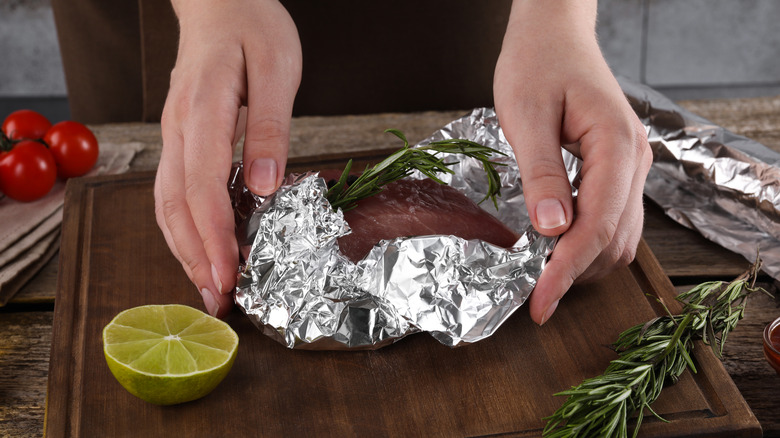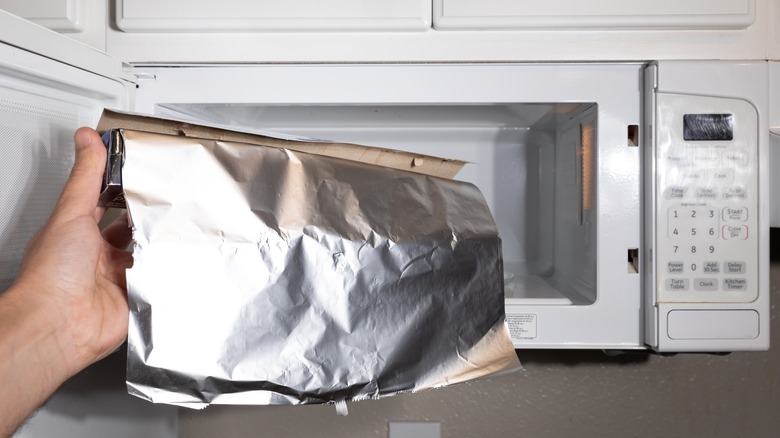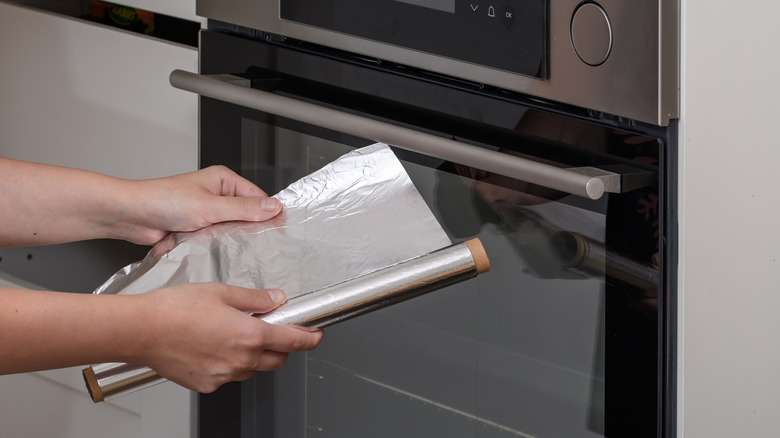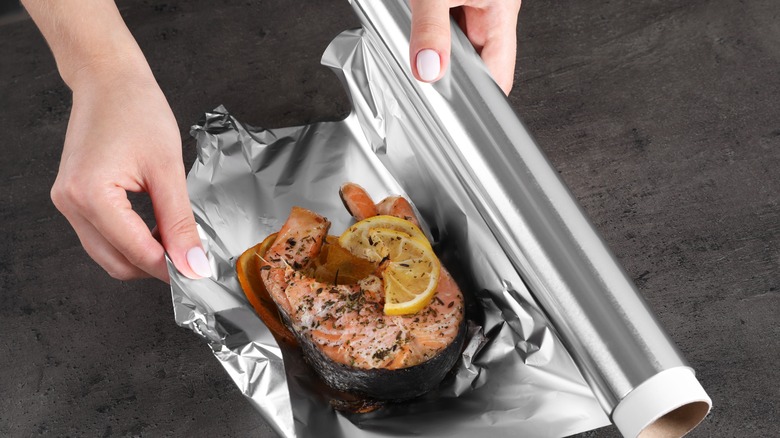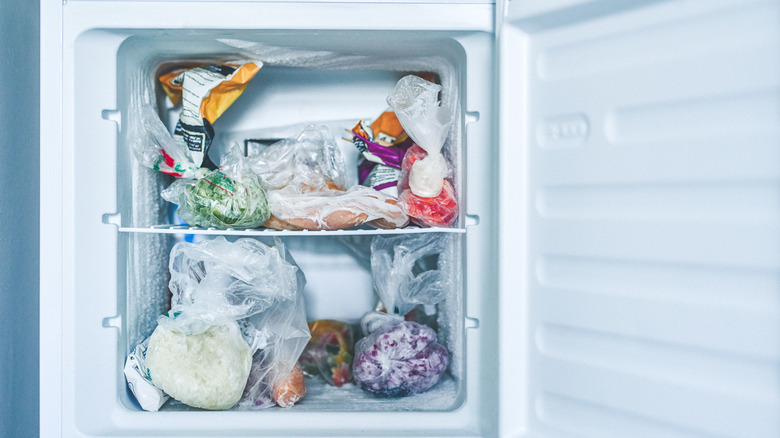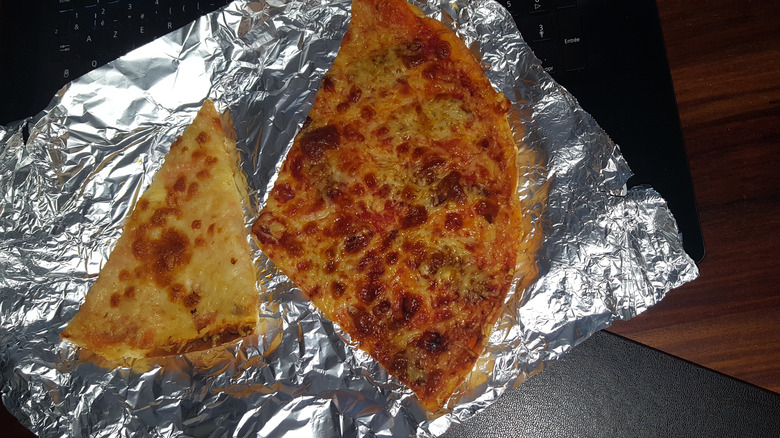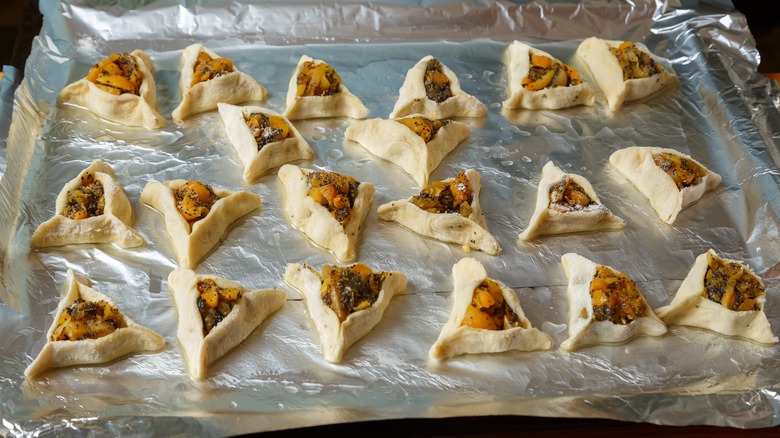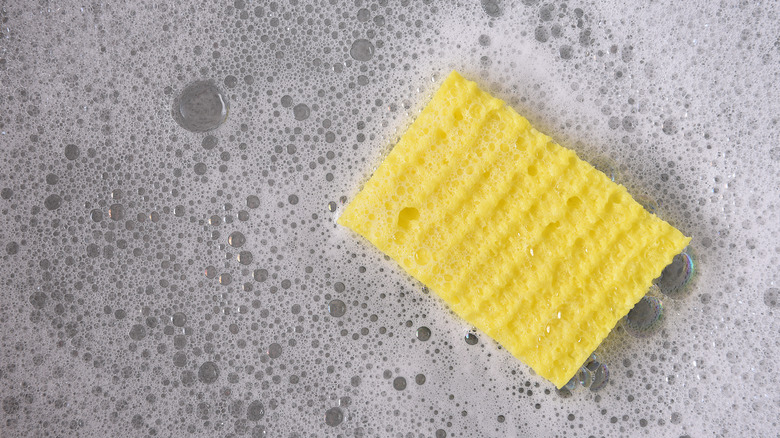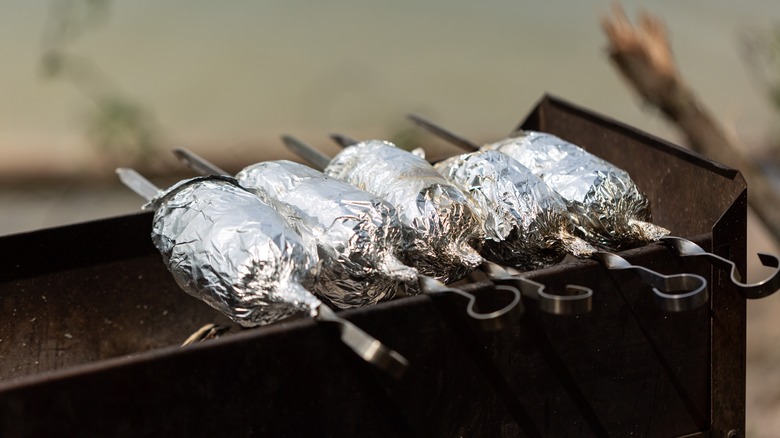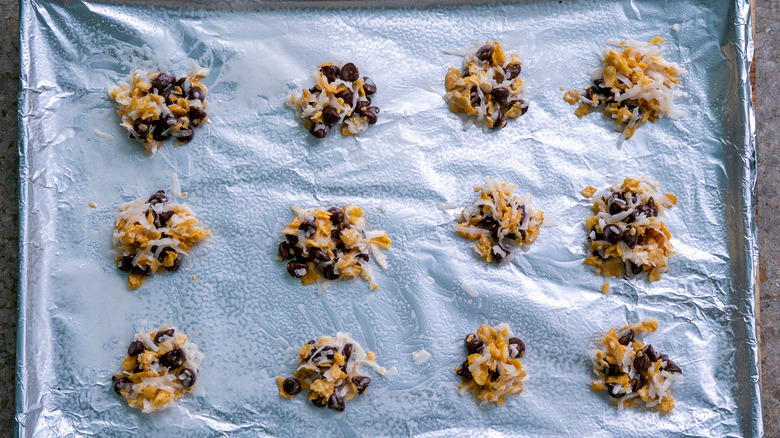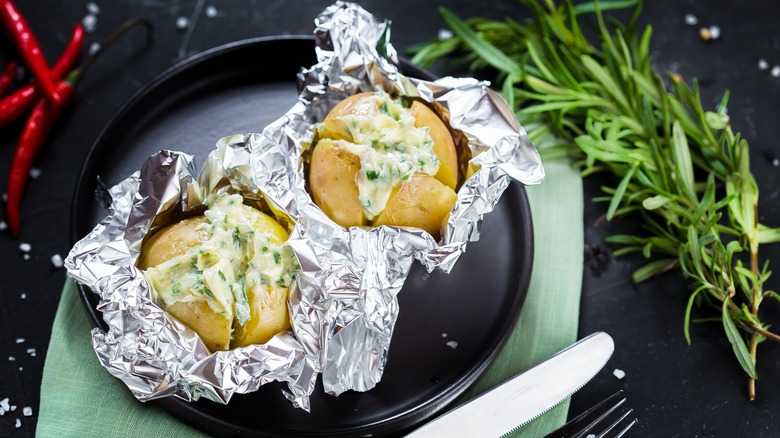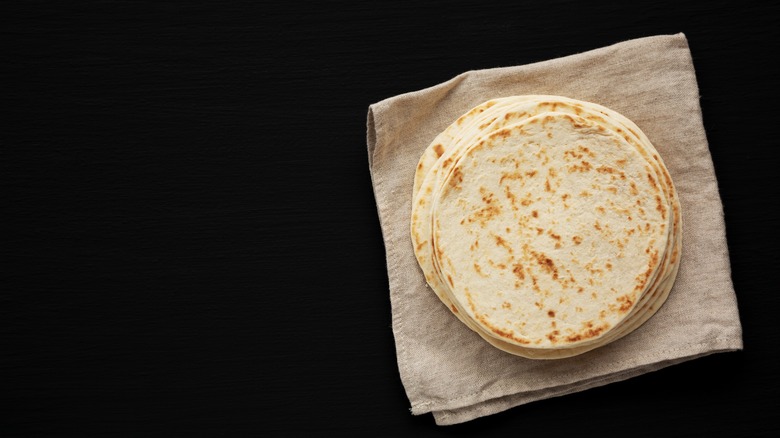You've Been Using Aluminum Foil All Wrong, According To Experts
Aluminum foil is a kitchen essential that you likely give little thought to — until you run out and are left wondering whether to use baking parchment instead and go without. It's not the most exciting or intriguing of kitchen topics, but learning the dos and don'ts of this staple can help you be a better cook. It's the sort of thing that people assume they know how to handle, when they could actually be making some common mistakes.
We spoke to four cooking experts and, according to them, you've been using aluminum foil all wrong. What's more, you probably didn't even know it. If you've been covering the bottom of your oven in foil to prevent messes, that's a mistake. Maybe you often refrigerate food wrapped in aluminum foil. Well, our experts say that's all wrong, too.
Don't be disheartened. Everyone makes mistakes. And we're not about to just tell you what you're doing wrong and leave it at that. Rather, we'll go over some common errors home cooks often make with aluminum foil and tell you how to fix them or what to do instead. It can make all the difference to your kitchen prowess, so you'll soon be on your way to leveling up your cooking skills.
Using aluminum foil in the microwave
Most people have heard that using aluminum foil in the microwave is a bad idea. But, you might think that it's just one of those things grownups say when you're a kid with little truth behind it. While it might not cause problems every time, it can be a real hazard, so if you're microwaving your foil, you should stop now.
"When exposed to the high voltage of the microwave, the metal in aluminum foil can create an electric current that can lead to sparking, which potentially causes a fire hazard and damages your microwave," explains Gocha Hawkins, chef and founder of Gocha's Restaurant Group. So, that's the science behind why you shouldn't use foil in a microwave. Maya Krampf of Wholesome Yum says that some argue that you can use foil in a microwave, but "it has to lay just right without wrinkles to prevent sparks that can lead to a fire." She adds that it's "not worth the risk!"
We get that it's annoying to unwrap or uncover food that's already got foil on it. However, it's only a small extra step and well worth doing it to prevent a potential fire. "You've seen those TikTok videos where the kitchen blows up in flames? Don't be that guy," says cookbook author and food blogger Brian Theis of The Infinite Feast. Grace Vallo of Tastefully Grace notes that you can "use microwave-safe containers or covers" instead when reheating food.
Covering the bottom of the oven with foil
You're sick and tired of cleaning up the oil and bits of food that drop to the bottom of the oven. So, you come up with a genius solution — cover the base of the oven with foil. It seems like a great idea. When it gets dirty, you can just lift it up and throw it in the trash. Unfortunately, this could lead you into trouble.
"When it comes to a conventional oven, don't line the bottom with foil to catch drippings," says Brian Theis. "At best, it will throw the temperature off," he adds. Grace Vallo agrees, saying that it "obstructs heat distribution, causing uneven cooking." There is an even bigger issue when using aluminum foil to cover the bottom of a convection oven. If it blocks the vents, it could lead to a rise in temperature that ultimately causes the foil to set fire.
If you can't line the bottom of the oven, what should you do? According to Vallo, if you want to protect your oven, you can put a larger baking tray underneath the shelf your food is on to catch anything that drips down. She also suggests that removable oven liners are an option — though you should check they're safe and compatible with your oven type. You might not like this suggestion, but you could also just let the food drip where it may and clean your oven every once in a while.
Wrapping acidic foods with foil
Most people think that it's alright to wrap any food with aluminum foil. After all, if it's food-safe, there's no reason to believe that you shouldn't wrap up whatever you like in it. Contrary to that assumption, you should avoid wrapping acidic foods with foil. Grace Vallo says that acidic ingredients react with foil, "causing a metallic taste."
You probably think of most things that you cook with as being fairly inert and stable, but aluminum is a highly reactive metal. While it's fine to use for most purposes, foil and acidic foods don't mix. But, it's not just wrapping food that's the problem. You shouldn't cook foods that contain lemon on aluminum foil — and the same goes for other acidic foods, such as tomatoes or pickles.
There can also be issues with very salty foods. "If your food has a high amount of sodium or acidity, you do not want to use foil for those items as the aluminum foil may cause a bad reaction," says Gocha Hawkins. There would have to be an extreme amount of salt in the recipe, so you don't need to worry in most cases. It's also worth noting that it's safe to eat acidic foods that have been wrapped or cooked with foil, it will just impact the flavor somewhat.
Not using foil to prevent freezer burn
If you aren't using foil when wrapping up food you're going to store in the freezer, you're making a mistake. The trouble with freezing food is that it can lead to freezer burn, which is when food is discolored or damaged by the cold conditions in a freezer — often due to improper wrapping. To avoid freezer burn, plastic wrap isn't enough. You need to give foil a chance, too.
Learning how to prevent freezer burn will help avoid food going to waste and there isn't just one method for it. The key is making sure you remove as much air as possible from the wrapping and that you have a protective layer between the food and the airtight outer layer — and this is where foil comes in handy. Start by wrapping the food you want to store in a double layer of foil. This will offer extra thermal protection and you can easily wrap it tightly so there's minimal air in there. Then, you can put the foil-wrapped food in an airtight container, such as a freezer bag or freezer-safe food storage box.
Of course, this method doesn't work well for wetter foods that you can't wrap in foil. In this case, freeze them in a freezer bag with as much air squeezed out as possible. Once frozen, remove it from the freezer, wrap it in two layers of foil, and put it in another freezer bag or food storage container.
Storing leftovers wrapped in aluminum foil
You've got a leftover slice of pizza or frittata. Wrapping it up in foil and putting it in the fridge might seem like the obvious storage solution. Or, if you have a plate or bowl of food you want to save for later, it seems to make sense to wrap it in foil to save you transferring it to a storage container. But, in fact, you should think twice before using foil to wrap leftovers.
"I don't recommend storing food wrapped in foil because it's not airtight," says Maya Krampf. Brian Theis agrees that foil isn't the best storage option for this reason. "Foil, unless perfectly rolled up and tightly closed, may encourage bacterial growth that will definitely spoil your next potluck," he says. Keeping air out of your food keeps it from spoiling as quickly. And, since foil isn't airtight, it just doesn't cut it.
If not foil, what should you use? "Airtight containers work better for storage, especially glass ones since they are not reactive," Krampf recommends. So, while it might be quick and easy to wrap leftovers in foil, a Tupperware container or similar is your best bet. It also reduces waste, so you can feel better about your decisions without the guilt of throwing out foil.
Using foil to prevent food sticking to baking sheets
Some people believe that foil keeps food from sticking to baking sheets, but this just isn't true. There are reasons why you might want to line a baking sheet with aluminum foil, but to stop sticking isn't one of them. "Yes, you can line baking sheets with foil for easier cleanup, but it's not an effective strategy to prevent sticking," remarks Maya Krampf.
Unless the foil that you're using is specifically marked as nonstick foil, there's no reason to think that food won't stick to it. This can leave you in a situation where you end up with bits of foil adhered to your food that you desperately have to try to peel off to avoid wasting your dinner. It's better to use a bare pan in these cases, because at least if the food sticks, the pans won't come with it when you try to pry it off with a spatula.
There are alternatives if you prefer a barrier. "I recommend parchment paper instead if the food you're making has a tendency to stick," says Krampf. There's also the option to buy nonstick foil, which I use regular and find highly effective. It's especially great when you want a nonstick surface without the loss of browning power that comes with using baking parchment.
Not reusing aluminum foil
Most of us use aluminum foil and then promptly crumple it up and throw it in the recycling bin. Yes, it's great that you can recycle foil. But, better yet, you should be reusing it. Not only is it better for the environment — the recycling process takes energy and resources — but it's kinder on your wallet, too.
According to Maya Krampf, "you can wash and reuse foil if you want to reduce the amount you use." If you rolled your eyes at a parent or grandparent telling you to reuse foil when you were younger, you're about to feel bad for ignoring their advice. What's cool is that you can actually wash it in the dishwasher — though you'll need to weigh it down with something. So, if the idea of scrubbing used foil by hand doesn't appeal, you're in luck. Sometimes foil is even clean enough to reuse with a quick wipe or rinse.
However, not all of our experts agree. "I would not reuse aluminum foil simply because of the spread of bacteria and the transfer of previous flavors," says Gocha Hawkins. "As aluminum foil is inexpensive, it's not going to hurt to use a fresh piece of foil to be safe." Of course, we're not suggesting using soiled foil — it should be washed first or already clean. But, if the thought of reusing foil grosses you out or you just don't want to make the effort, you've got Hawkins on your side.
Wrapping food too tightly when cooking it
Some food calls for being wrapped in or covered with foil while it cooks. Your instinct might be to wrap it up firmly or cover the dish tightly and seal up the edges, but this isn't always the best way to do it. You need to consider the recipe before deciding whether it needs a loose or tight covering or wrapping. In some cases, the recipe will specify, but other times you might need to figure it out for yourself.
According to Grace Vallo, wrapping food too tightly in foil can cause it to steam instead of roast. So, rather than getting a crisp or caramelized finish, you might end up with something soggy or watery. To solve this, "wrap loosely to allow air circulation, unless steaming is intended," says Vallo.
Gocha Hawkins backs this up: "To savor the juices when steaming dishes, wrap the foil tightly." Maya Krampf confirms that wrapping food tightly in foil also locks in moisture. If you want a dish to be moist or succulent, a firm wrap is the way to go. Sometimes foil is simply used to keep foods from catching during a long cook time. "When I am covering just to reduce browning (such as a roasted chicken or a pound cake for part of the baking time), I prefer to tent the food loosely," Krampf explains.
Not realizing that cooking on foil increases browning
Aluminum foil isn't just for wrapping — many people also cook on baking sheets or in roasting dishes lined with foil. As Gocha Hawkins puts it, this "makes for an easy cleanup afterward," but if you're used to using baking parchment to line your pans, it's important to understand the difference in browning speed.
"The most common mistake I see is not knowing when to use foil versus parchment paper or using them interchangeably," says Maya Krampf. "Parchment paper works best to prevent sticking but doesn't work as well for browning foods." So, if you want foods to brown quickly, then using foil is a good idea. When you don't want too much browning, it's better to stick to parchment paper.
According to Brian Theis, one of the most notable examples of this is when baking cookies. Do it on a foil-lined baking sheet and you run the risk of overcooking the bottom of the cookies, because the foil conducts too much heat. He notes that you should use parchment for cookies, unless the recipe calls for a naked cookie sheet. If you occasionally end up with cookies that have overbaked bottoms and can't figure out why, it might be simply that you're lining the sheet with the wrong material.
Baking potatoes wrapped in foil
It's fairly common to cook baked potatoes wrapped in foil. And, at first glance, it seems like a technique that makes sense. The foil conducts heat, which seems like it could speed up cooking. Plus, it keeps any juices locked inside, making it quicker and easier to clean up after cooking — something that appeals to pretty much everyone. But, there's a good reason why you should never bake potatoes in foil.
"Don't bake potatoes wrapped in foil," Brian Theis warns. "You will sacrifice your crisp potato skin and the light and fluffy interior and end up with a moist, even soggy spud instead." It's a one-way street to underwhelming potatoes. You won't get that crisp exterior and fluffy interior that a good baked potato has. Rather, the skin will be soft and soggy and the inside will be dense and gluey, instead of fluffy, because the moisture won't have had a chance to cook out.
How should you make a simple baked potato instead? You'll find a range of methods, but most start with washing and drying potatoes, rubbing them with olive oil, sprinkling them with salt, and pricking them all over with a fork. This last step is especially important to keep them from exploding in the oven. Then, cook for somewhere between 1 hour and 2 hours 20 minutes at 350 to 425 F. Longer, lower bakes give you a crispier skin.
Not making the most of aluminum foil
We've talked about all the things you might be doing wrong with aluminum foil. But, what about all the things it does well that you're not making the most of? Failing to use it to its full potential is a mistake in its own right. Once you know some of the helpful things you can do with it, you won't miss out.
"Foil is great when you want to increase the heat around an ingredient quickly," says Brian Theis. "Example: warming up tortillas for taco night — just fire up your oven to 225 or 250 F, wrap your tortillas tightly in foil, and in 10 or 15 minutes, it's fiesta time!" He notes that the foil also helps keep moisture in so the tortillas don't dry out.
There are some surprising uses for aluminum foil. You can scrunch it up and use it to scrub and clean your grill with surprisingly effective results. It also cleans up silverware — just line a pan with foil, add your dirty flatware, then add two teaspoons of salt and enough cold water to cover it. Soak for five minutes then rinse the cutlery and wipe it down.
Need a funnel? It's easy to craft a makeshift alternative from foil. And it's easy to use foil to cover just the edges of a pie crust to keep them from burning while the rest of the pie gets nicely browned. You can do all this and more with simple foil.
